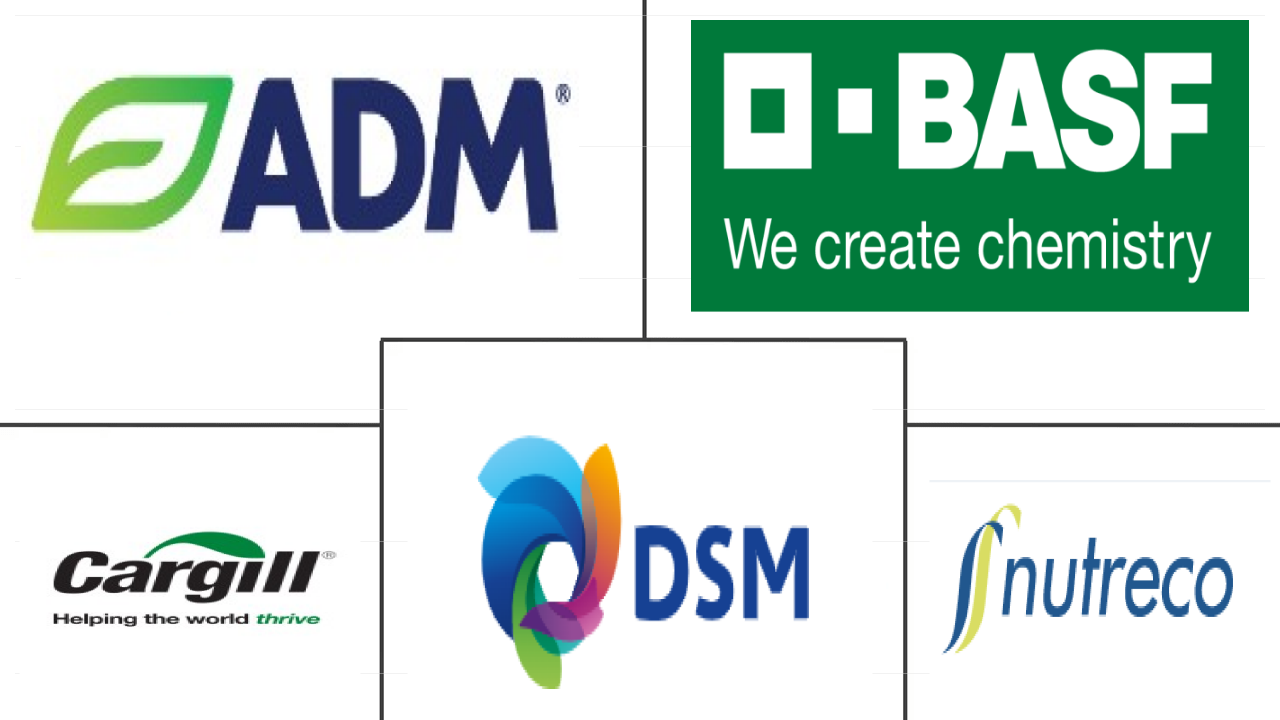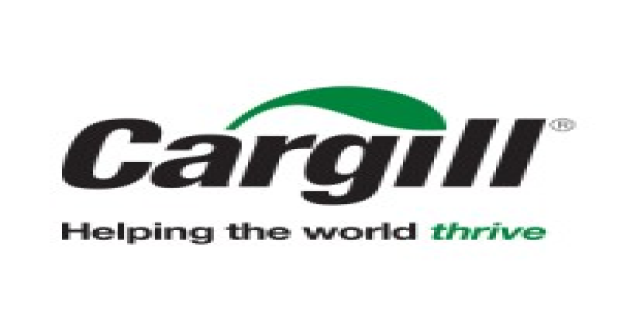Market Size of indonesia feed additives Industry
| Icons | Lable | Value |
|---|---|---|
|
|
Study Period | 2017 - 2029 |
|
|
Market Size (2024) | USD 441.88 Million |
|
|
Market Size (2029) | USD 580.01 Million |
|
|
Largest Share by Additive | Amino Acids |
|
|
CAGR (2024 - 2029) | 5.59 % |
|
|
Fastest Growing by Additive | Acidifiers |
|
|
Market Concentration | Low |
Major Players |
||

|
||
|
*Disclaimer: Major Players sorted in no particular order |
Indonesia Feed Additives Market Analysis
The Indonesia Feed Additives Market size is estimated at 441.88 million USD in 2024, and is expected to reach 580.01 million USD by 2029, growing at a CAGR of 5.59% during the forecast period (2024-2029).
441.88 Million
Market Size in 2024 (USD)
580.01 Million
Market Size in 2029 (USD)
6.33 %
CAGR (2017-2023)
5.59 %
CAGR (2024-2029)
Largest Market by Additive
23.49 %
value share, Amino Acids, 2023
Amino Acids are the largest segment in the market due to the increase in awareness to balance the gut pH, increase in livestock population, and reduce infections.
Largest Market by Animal
57.31 %
value share, Poultry, 2023
Poultry is the largest segment due to increased feed production, an increase in egg production to meet consumers' demand, and the high demand for poultry meat.
Fastest-growing Market by Additive
6.32 %
Projected CAGR, Acidifiers, 2024-2029
Acidifiers are the fastest-growing segment as it helps increase animal feed intake, provide resistance to bacteria, improve immunity, and reduce antibiotic dependence.
Fastest-growing Market by Animal
6.36 %
Projected CAGR, Poultry, 2024-2029
The poultry segment has witnessed the fastest growth in the market due to increased demand for eggs and poultry meat for consumption and feed production.
Leading Market Player
7.40 %
market share, Cargill Inc., 2022

Cargill Inc. is the market leader as It has expanded its product portfolio by investing in Research and Development activities and acquiring new feed mills in Indonesia.
- The Indonesian animal feed industry relies heavily on amino acids, binders, minerals, and probiotics as feed additives, which accounted for 54% of the feed additives market in 2022. The market saw a significant increase of 23.8% in 2020 compared to 2019, driven by the surge in demand from international markets for aquaculture and swine production.
- In Indonesia, lysine and methionine were the most significant feed amino acids in terms of market value, accounting for 33.6% and 31.3%, respectively, in 2022. The high share of lysine and methionine is due to their efficiency characteristics, such as improved gut health, easy digestion, and enhanced meat production.
- Synthetic binders held the largest share in 2022, accounting for 67.1% of the total feed binders market in the country. Synthetic feed binders not only assist in pelleting the feed but also prevent diseases by improving digestion and nutrition intake in animals.
- Poultry birds were the primary animal types in the feed additives market, representing 56.8% of the market share value in 2022 due to their high feed intake and the larger feed production, which exceeded 10.4 million metric ton in 2022.
- The fastest-growing segment in the feed additives market is acidifiers, and it is expected to record a CAGR of 6.3% during the forecast period. Acidifiers promote growth, increase metabolism, and reduce dependence on antibiotics.
- Due to the importance of feed additives in animal nutrition, the demand for feed additives in the country is expected to record a CAGR of 5.6% during the forecast period (2023-2029).
Indonesia Feed Additives Industry Segmentation
Acidifiers, Amino Acids, Antibiotics, Antioxidants, Binders, Enzymes, Flavors & Sweeteners, Minerals, Mycotoxin Detoxifiers, Phytogenics, Pigments, Prebiotics, Probiotics, Vitamins, Yeast are covered as segments by Additive. Aquaculture, Poultry, Ruminants, Swine are covered as segments by Animal.
- The Indonesian animal feed industry relies heavily on amino acids, binders, minerals, and probiotics as feed additives, which accounted for 54% of the feed additives market in 2022. The market saw a significant increase of 23.8% in 2020 compared to 2019, driven by the surge in demand from international markets for aquaculture and swine production.
- In Indonesia, lysine and methionine were the most significant feed amino acids in terms of market value, accounting for 33.6% and 31.3%, respectively, in 2022. The high share of lysine and methionine is due to their efficiency characteristics, such as improved gut health, easy digestion, and enhanced meat production.
- Synthetic binders held the largest share in 2022, accounting for 67.1% of the total feed binders market in the country. Synthetic feed binders not only assist in pelleting the feed but also prevent diseases by improving digestion and nutrition intake in animals.
- Poultry birds were the primary animal types in the feed additives market, representing 56.8% of the market share value in 2022 due to their high feed intake and the larger feed production, which exceeded 10.4 million metric ton in 2022.
- The fastest-growing segment in the feed additives market is acidifiers, and it is expected to record a CAGR of 6.3% during the forecast period. Acidifiers promote growth, increase metabolism, and reduce dependence on antibiotics.
- Due to the importance of feed additives in animal nutrition, the demand for feed additives in the country is expected to record a CAGR of 5.6% during the forecast period (2023-2029).
| Additive | |||||||||||
| |||||||||||
| |||||||||||
| |||||||||||
| |||||||||||
| |||||||||||
| |||||||||||
| |||||||||||
| |||||||||||
| |||||||||||
| |||||||||||
| |||||||||||
| |||||||||||
| |||||||||||
| |||||||||||
|
| Animal | |||||||
| |||||||
| |||||||
| |||||||
| Swine | |||||||
| Other Animals |
Indonesia Feed Additives Market Size Summary
The Indonesia Feed Additives Market is poised for significant growth, driven by the increasing demand for animal nutrition solutions. The market is characterized by a strong reliance on amino acids, binders, minerals, and probiotics, which collectively dominate the feed additives sector. The poultry industry, in particular, plays a crucial role, with poultry birds accounting for a substantial portion of the market share due to their high feed intake and production levels. Despite challenges such as fluctuations in poultry production and market dynamics, the demand for feed additives remains robust, supported by the rising consumption of poultry meat and eggs. The market is also witnessing a shift towards acidifiers, which are gaining traction for their benefits in promoting growth and reducing antibiotic dependence.
In addition to poultry, the aquaculture sector significantly contributes to the feed additives market, with Indonesia being one of the largest aquaculture producers globally. The growth in aquaculture feed production, driven by increased per capita consumption and government support, underscores the expanding opportunities in this segment. Fish and shrimp dominate the aquaculture feed market, with fish holding the largest share due to its dietary benefits and international demand. The market landscape is fragmented, with key players like Archer Daniel Midland Co., BASF SE, Cargill Inc., DSM Nutritional Products AG, and SHV (Nutreco NV) leading the charge. Recent strategic moves, such as acquisitions and product introductions, highlight the ongoing innovation and competitive dynamics within the market, setting the stage for continued expansion in the coming years.
Indonesia Feed Additives Market Size - Table of Contents
-
1. MARKET SEGMENTATION (includes market size in Value in USD and Volume, Forecasts up to 2029 and analysis of growth prospects)
-
1.1 Additive
-
1.1.1 Acidifiers
-
1.1.1.1 By Sub Additive
-
1.1.1.1.1 Fumaric Acid
-
1.1.1.1.2 Lactic Acid
-
1.1.1.1.3 Propionic Acid
-
1.1.1.1.4 Other Acidifiers
-
-
-
1.1.2 Amino Acids
-
1.1.2.1 By Sub Additive
-
1.1.2.1.1 Lysine
-
1.1.2.1.2 Methionine
-
1.1.2.1.3 Threonine
-
1.1.2.1.4 Tryptophan
-
1.1.2.1.5 Other Amino Acids
-
-
-
1.1.3 Antibiotics
-
1.1.3.1 By Sub Additive
-
1.1.3.1.1 Bacitracin
-
1.1.3.1.2 Penicillins
-
1.1.3.1.3 Tetracyclines
-
1.1.3.1.4 Tylosin
-
1.1.3.1.5 Other Antibiotics
-
-
-
1.1.4 Antioxidants
-
1.1.4.1 By Sub Additive
-
1.1.4.1.1 Butylated Hydroxyanisole (BHA)
-
1.1.4.1.2 Butylated Hydroxytoluene (BHT)
-
1.1.4.1.3 Citric Acid
-
1.1.4.1.4 Ethoxyquin
-
1.1.4.1.5 Propyl Gallate
-
1.1.4.1.6 Tocopherols
-
1.1.4.1.7 Other Antioxidants
-
-
-
1.1.5 Binders
-
1.1.5.1 By Sub Additive
-
1.1.5.1.1 Natural Binders
-
1.1.5.1.2 Synthetic Binders
-
-
-
1.1.6 Enzymes
-
1.1.6.1 By Sub Additive
-
1.1.6.1.1 Carbohydrases
-
1.1.6.1.2 Phytases
-
1.1.6.1.3 Other Enzymes
-
-
-
1.1.7 Flavors & Sweeteners
-
1.1.7.1 By Sub Additive
-
1.1.7.1.1 Flavors
-
1.1.7.1.2 Sweeteners
-
-
-
1.1.8 Minerals
-
1.1.8.1 By Sub Additive
-
1.1.8.1.1 Macrominerals
-
1.1.8.1.2 Microminerals
-
-
-
1.1.9 Mycotoxin Detoxifiers
-
1.1.9.1 By Sub Additive
-
1.1.9.1.1 Binders
-
1.1.9.1.2 Biotransformers
-
-
-
1.1.10 Phytogenics
-
1.1.10.1 By Sub Additive
-
1.1.10.1.1 Essential Oil
-
1.1.10.1.2 Herbs & Spices
-
1.1.10.1.3 Other Phytogenics
-
-
-
1.1.11 Pigments
-
1.1.11.1 By Sub Additive
-
1.1.11.1.1 Carotenoids
-
1.1.11.1.2 Curcumin & Spirulina
-
-
-
1.1.12 Prebiotics
-
1.1.12.1 By Sub Additive
-
1.1.12.1.1 Fructo Oligosaccharides
-
1.1.12.1.2 Galacto Oligosaccharides
-
1.1.12.1.3 Inulin
-
1.1.12.1.4 Lactulose
-
1.1.12.1.5 Mannan Oligosaccharides
-
1.1.12.1.6 Xylo Oligosaccharides
-
1.1.12.1.7 Other Prebiotics
-
-
-
1.1.13 Probiotics
-
1.1.13.1 By Sub Additive
-
1.1.13.1.1 Bifidobacteria
-
1.1.13.1.2 Enterococcus
-
1.1.13.1.3 Lactobacilli
-
1.1.13.1.4 Pediococcus
-
1.1.13.1.5 Streptococcus
-
1.1.13.1.6 Other Probiotics
-
-
-
1.1.14 Vitamins
-
1.1.14.1 By Sub Additive
-
1.1.14.1.1 Vitamin A
-
1.1.14.1.2 Vitamin B
-
1.1.14.1.3 Vitamin C
-
1.1.14.1.4 Vitamin E
-
1.1.14.1.5 Other Vitamins
-
-
-
1.1.15 Yeast
-
1.1.15.1 By Sub Additive
-
1.1.15.1.1 Live Yeast
-
1.1.15.1.2 Selenium Yeast
-
1.1.15.1.3 Spent Yeast
-
1.1.15.1.4 Torula Dried Yeast
-
1.1.15.1.5 Whey Yeast
-
1.1.15.1.6 Yeast Derivatives
-
-
-
-
1.2 Animal
-
1.2.1 Aquaculture
-
1.2.1.1 By Sub Animal
-
1.2.1.1.1 Fish
-
1.2.1.1.2 Shrimp
-
1.2.1.1.3 Other Aquaculture Species
-
-
-
1.2.2 Poultry
-
1.2.2.1 By Sub Animal
-
1.2.2.1.1 Broiler
-
1.2.2.1.2 Layer
-
1.2.2.1.3 Other Poultry Birds
-
-
-
1.2.3 Ruminants
-
1.2.3.1 By Sub Animal
-
1.2.3.1.1 Beef Cattle
-
1.2.3.1.2 Dairy Cattle
-
1.2.3.1.3 Other Ruminants
-
-
-
1.2.4 Swine
-
1.2.5 Other Animals
-
-
Indonesia Feed Additives Market Size FAQs
How big is the Indonesia Feed Additives Market?
The Indonesia Feed Additives Market size is expected to reach USD 441.88 million in 2024 and grow at a CAGR of 5.59% to reach USD 580.01 million by 2029.
What is the current Indonesia Feed Additives Market size?
In 2024, the Indonesia Feed Additives Market size is expected to reach USD 441.88 million.

